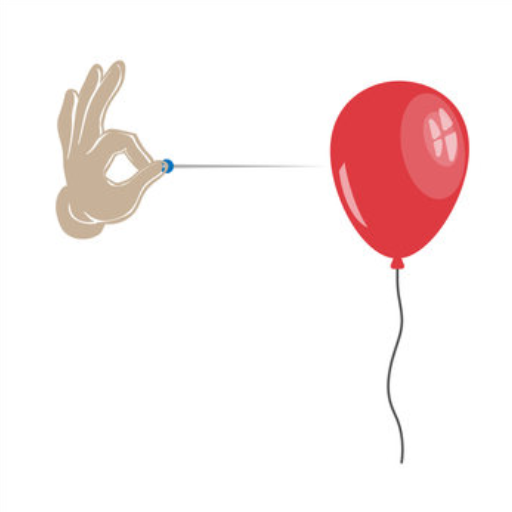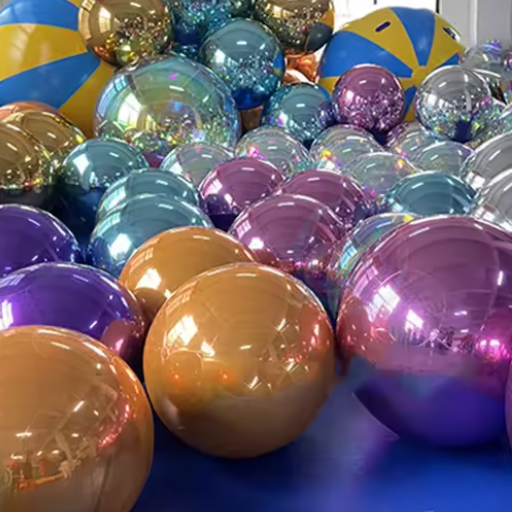Like any balloon popping in a usual way, it erupts with an unbearably loud bang that makes everyone stop to notice it. However, if you had ever seen a helium balloon bursting, you would have noticed something more silent. How come? What makes helium balloons pop so differently? This interesting phenomenon is tied to helium’s properties and the constructional dynamics of the balloon itself. In this blog, we talk about the subtle yet significant differences in the science behind the factors affecting sound production during a balloon burst. Get set to witness a surprising chemistry and physics combo explaining why all pops are not created equally!
What Makes a Foil Balloon Different from a Latex Balloon?

The differentiation between foil balloons and latex balloons is chiefly based on the materials they are made from and how the materials behave. They are first made of a thin layer of metal-coated plastic, thus giving it a bright appearance and slightly less porous while holding the helium or air for a more extended period than a latex balloon. Latex balloons are made using natural rubber, which renders the balloon more elastic and porous, hence losing helium or air faster. Moreover, foil balloons can be described as more rigid and durable, which do not burst easily; on the other hand, latex balloons are almost sure to pop because of the smaller thickness and stretchability of the material.
Composition and Material: Understanding Mylar vs. Latex
|
Parameter |
Mylar Balloons |
Latex Balloons |
|---|---|---|
|
Material |
Metallic polyester film |
Natural rubber latex |
|
Appearance |
Shiny, reflective |
Matte or glossy |
|
Durability |
Long-lasting, weeks with helium |
Short-lived, 12-24 hours with helium |
|
Eco-Friendliness |
Non-biodegradable |
Biodegradable |
|
Customization |
Ideal for detailed designs |
Easy to print logos or graphics |
|
Cost |
More expensive |
Affordable |
|
Allergy Concerns |
Hypoallergenic |
May cause latex allergies |
|
Temperature Impact |
Sensitive to temperature changes |
Less sensitive |
|
Helium Retention |
Airtight, retains helium longer |
Porous, helium escapes quickly |
|
Best Use |
Formal events, long-term decor |
Casual events, short-term decor |
Why Do Foil Balloons Not Make the Pop Sound?
The characteristic pop sound that one hears when a latex balloon bursts rarely happens when a foil (Mylar) balloon pops because of differences in composition and structural construction. The pop sound in latex balloons is mainly caused by the rapid tearing of stretched elastic material that snaps back once it is punctured. Being highly elastic, the stretched surface of latex balloons stores potential energy that is released explosively when the surface tension is tampered with.
The character of foil balloons, on the other hand, is formed by a non-elastic sheet of metallic plastic. When punctured, the material simply stays put and tears or splits without releasing much of the stored energy. The steel cut slower and less violently and consequently made no sound when it broke.
Research has also shown that internal air pressure within foil balloons is often less than that within latex balloons of the same size. The lower air pressure inside therefore diminishes the chances of the storage buildup being violently released. For instance, a research study revealed that latex balloons might maintain an internal pressure as high as 8-10 psi (pounds per square inch), whereas foil balloons adapt an internal pressure of just 2-4 psi, meaning the force of rupture is greatly diminished.
Another factor is the acoustic properties of the substances. Latex, owing to its elastic nature, can transmit sound waves better, contributing to the acuteness of the popping noise. Contrarily, Mylar, being hard and layered, absorbs sound waves, deadening the sharpness of a rupture. These differences emphasize the interaction between material science and physical properties as applied to the behavior of balloons when punctured.
The Role of Air Pressure Inside Different Balloons
While air pressure can very much influence a balloon’s behavior when inflating it or puncturing it, something small about the internal pressure changes in the balloon would cause the elasticity, the sound of breaking, and even an abrupt rupture to vary. Below, in detail, we will discuss one or two factors regarding air pressure that affect the behavior of different types of balloons:
- Pressure versus Stretchability
Generally, more air pressure stretches the balloon’s material, increasing its elasticity. Latex balloons, for instance, stretch more, thereby adding tension that later contributes to the startling pop sound once the balloon bursts.
- Effect of Over-inflation
Overinflating a balloon means the internal air pressure is raised much more than what the balloon could sustain under normal circumstances, tending to push the material beyond its threshold. This essentially creates a more explosive rupture when it does give in to a puncture, be that an overfilled latex balloon or an overfilled Mylar balloon.
- Shapes and Pressure Distribution
The shape of a balloon determines pressure distribution over its surface. For round balloons, pressure tends to be evenly distributed all over, while irregular shapes have some spot high-stress areas and will give an uneven rupture.
- Temperature Effect
Inside balloons, air pressure is very dependent on temperature; hence, as temperature goes up, air expands with it, leading to a rise in pressure within the balloon. This effect poses the risk of premature bursting, especially to tightly stretched latex models.
- Pressure Comparison for Latex and Mylar
Latex balloons generally hold more water pressure internally because of the stretch, which enables a louder pop. Mylar, being less elastic, holds less pressure and has a softer pop when punctured.
These factors show in detail how air pressure determines balloon behavior and properties, and thus provide some insight into their performance under different working conditions.
Why Do Helium Balloons Behave Differently?

Unlike air, helium, being lighter, allows the balloons to float. Unlike air, which comprises a mixture of gases, helium is an inert gas with a low density that enables balloons to rise in the atmosphere. Another reason for helium is that it diffuses faster through balloon materials like latex. Because of this, helium balloons deflate quicker than air-filled balloons. These distinctions arise mainly because of helium’s peculiar physical properties.
What Happens When You Inflate a Balloon with Helium?
Because helium is the gas with a low density and almost zero chemical reactivity with any other elements, helium is well-suited to making balloons float into the sky, but, simultaneously, causes the balloon to deflate by the helium escaping through the balloon material openings.
How Does Pressure Inside the Balloon Influence Its Behavior?
The pressure within a balloon is a significant factor in determining its shape, durability, and performance. As the balloon inflates with more gas molecules, the inner pressure increases. This pressure pushes out the balloon’s inner walls, causing the balloon to expand. As the wall stretches, there can be little more warping of the film until it eventually ruptures. For standard party balloons, the maximum internal pressure they withstand can be around 8 psi (pounds per square inch), although it varies with material and thickness.
Another interesting factor affecting the helium balloon’s floating behavior is the pressure difference between the inside and the outside of the balloon. Usually, the inside helium pressure is a tad higher than the surrounding air pressure. Hence, the helium remains confined within the balloon until a period of time elapses. Tiny helium atoms escape through almost imperceptible pores in the balloon over time, decreasing the internal pressure, and the balloon eventually sinks.
An obvious factor affecting the inside pressure of a balloon is temperature. With heat, gas molecules move faster toward the inside of the balloon, increasing the internal pressure, overexpansion, and potentially bursting it; with cold air, the gas molecules slow down, and the balloon’s internal pressure drops, thus causing it to partially shrink, deflate, or sag. In reality, a helium balloon can shrink about 5-8% for every 10 °F drop in temperature.
The aforementioned revelation points towards the fact that internal pressure inside a balloon is a dynamic factor influenced by the kind and amount of gas or the surrounding environmental conditions.
Comparing the Bang of Helium and Air-Filled Balloons
|
Parameter |
Helium Balloons |
Air-Filled Balloons |
|---|---|---|
|
Floating Ability |
Floats due to lighter-than-air helium |
Does not float, stays grounded |
|
Lifespan |
Hours to days (depends on material) |
Days to weeks (longer-lasting) |
|
Cost |
More expensive |
Cost-effective |
|
Reusability |
Limited, mostly for Mylar balloons |
Reusable if deflated properly |
|
Visual Appeal |
Elegant, floating decorations |
Versatile for sculptures and arches |
|
Best Use |
Floating decor, centerpieces |
Grounded decor, balloon walls |
|
Environmental Impact |
Risk if released outdoors |
Less risk, but it depends on the material |
|
Ease of Inflation |
Requires helium tanks |
Easily inflated with air |
|
Safety |
Non-toxic, but helium displaces oxygen |
Safe, uses regular air |
|
Customization |
Wide range of shapes and designs |
Suitable for creative arrangements |
How Does the Surface of the Balloon Impact the Sound?

Surface of the balloon influences the sound: vibrations move across it. If the surface is smooth and well stretched, it would allow sound waves to propagate better, and thus louder and clearer sounds may be produced. On the other hand, if the surface is less smooth, it would scatter the vibrations, leading to either muffling or distortion of sound. The material and stretch of the balloon surface hold the secret away from the quality and clarity of sound it can produce.
What Happens at the Point on the Balloon When It Bursts?
At the moment of bursting, a detailed sequence of physical and mechanical events unfolds under the impact of the material properties, the air pressure, and the applied external force. The principal causes and phenomena noticed at the bursting include:
- Rapid Air Release
The pressurized air inside the balloon seemingly rushes out as the balloon’s surface starts to tear. This rapid expansion and acceleration of air generate a loud noise due to shockwave formation.
- Tension Threshold Break
The balloon material- the latex or similar elastic substance- is stretched to its utmost tensile strength. When the threshold of tension is exceeded, the holding force of the bonds that cling the material together is insufficient, and in an instant, the balloon blows.
- Propagation of Tears
The rupture starts from some minor point of weakness, such as where the balloon is punctured, and soon propagates in every direction, hurting the material into smaller fragments.
- Heat from Friction
While frictional forces between the two lip edges of torn material could generate heat, the fast process prevents any perceived heat.
- Fragmentation Patterns
The shape and size of the fragments depend on the initial pressure and the material’s elasticity. Balloons with higher pressure almost always break up into finer fragments, while those with lower air pressure tend to tear up into large pieces.
These observations illustrate how a complex set of forces acts on what appears to be just a simple object: Trying to understand tension, pressure, and materials science in action.
The Tensile Stress on Foil vs. Latex Balloons
|
Parameter |
Foil Balloons |
Latex Balloons |
|---|---|---|
|
Material |
Mylar (polyester film) |
Natural rubber latex |
|
Tensile Strength |
High, resists tearing |
Moderate, highly elastic |
|
Flexibility |
Limited, not stretchable |
Very flexible and stretchable |
|
Durability |
Resistant to punctures |
Prone to popping under stress |
|
Elasticity |
Low, retains shape |
High, stretches significantly |
|
Best Use |
Long-lasting, rigid shapes |
Dynamic, twistable shapes |
|
Environmental Impact |
Non-biodegradable |
Biodegradable |
|
Cost |
Higher |
Lower |
What is the Physics Behind a Balloon Popping?

An explosion in a balloon is the consequence of the tension building up in the material beyond its breaking point. Balloons are made from elastic materials such as rubber or latex, which stretch a bit under the pressure of the air or gas inside them. The pressure also rises with an increase in the amount of gas inside, leaving the material thinner and more stressed. Should this stress go beyond its tensile strength due to overinflation, undue pressure by a sharp object, or simply due to a weak spot in the material, the balloon will subsequently rupture. The energy stored inside is then suddenly released, producing the material’s loud banging and sudden fragmentation.
How Does a Puncture Cause the Balloon to Burst?
|
Key Point |
Explanation |
|---|---|
|
Internal Pressure |
High pressure inside pushes against the balloon wall. |
|
Material Tension |
Stretched material holds the pressurized air. |
|
Puncture Effect |
Creates a weak point, disrupting the material balance. |
|
Rapid Air Escape |
Air rushes out, increasing stress on the material. |
|
Tear Propagation |
Weak point expands, causing the balloon to rupture. |
|
Sound Production |
Rapid air release creates a loud popping sound. |
The Process of Rupture and Why It Doesn’t Always Result in a Loud Bang
Puncturing leads to various results depending on the size and sharpness of the object and an existing pressure distribution inside the balloon. If the sharp object creates a sudden clean puncture while the balloon is highly inflated, the internal tension will likely rupture the balloon rapidly with a loud bang. On the other hand, if the balloon is not highly pressurized or punctured gradually, it would allow the stress to dissipate slowly, with air escaping more silently rather than suddenly erupting.
Why Foil Balloons Don’t Pop as Loudly?

Since they’re made with a less elastic material than latex balloons, foil balloons can’t really pop loudly; they are more likely to rip slowly. This slow air leakage produces a quieter noise because the energy released by the puncture does not emerge quickly or with any boldness. Furthermore, being in rigid construction, foil delays mudding any noise the rupture produces.
The Differences in Internal Pressure and Elasticity
Deafening popping sounds are primarily influenced by the balloon’s internal pressure and its material’s elasticity. Latex balloons, being highly elastic, can stretch a great deal when inflated. This internal pressure is relatively high from the air forcefully pushing against the stretched latex medium. When a latex balloon is punctured or bursts, with the immediate release of elastic energy formed in its extent, a loud pop is heard, produced from the tearing of the material concurrent with a rapid, forceful outburst of air.
Low elasticity and hence less stretchability are the properties of foil balloons. Consequently, the balloons are inflated at a lower internal pressure than the latex balloons, as the leathery material is more difficult to stretch and may easily rupture. Such a lowered tensile state of the foil surface offers very little stored energy to be released when punctured; hence, instead of a loud pop, an escaping foil balloon is often accompanied by a slightly softer tearing sound.
Supporting Data
According to research and data from the study, latex balloons can make a noise of up to 155 dB when they pop. This is as loud as a gunshot or a fireworks explosion. This high-pressure level comes from the instantaneous release of air and the elastic recoil of the material. On the other hand, foil balloons exhibit much lower SPLs, generally less than 110 dB, when they come apart or tear, as the air doesn’t release as fast, and neither does the elastic force act.
Such distinctions in the intensities of the sounds caused by latex and foil balloons provide insight into their physical behavior and practical applications, tying them together with material properties and inflation levels.
How the Balloon is Filled Affects the Sound
| Gas Type | Effect on Sound | Key Parameter |
|---|---|---|
|
Air |
Minimal effect on sound |
Similar sound velocity to air |
|
Helium (He) |
Higher pitch, faster sound travel |
2.7x sound velocity of air |
|
Carbon Dioxide (CO2) |
Amplifies sound, acts as a converging lens |
0.78x sound velocity of air |
|
Sulfur Hexafluoride (SF6) |
Strong sound focus, converging lens effect |
0.44x sound velocity of air |
References
-
Quora: Explains that foil balloons are not elastic like latex balloons, resulting in minimal pressure differences inside and outside, which prevents the loud “pop” sound when punctured.
Visit Source -
MWM Research Group: Provides detailed insights into the material properties and behavior of balloons, including elasticity and pressure dynamics, which help explain the quieter nature of foil balloons.
Visit Source -
HowStuffWorks: Discusses the differences between latex and foil balloons, focusing on material properties and how they affect helium retention and sound production.
Visit Source
Frequently Asked Questions (FAQ)
Q: Why doesn’t a helium balloon create a loud bang when it pops?
A: Helium-filled balloons often don’t make a loud bang due to the lower pressure difference between the helium inside the balloon and the surrounding air. The energy stored inside a latex balloon is less when filled with helium than compressed air because helium is less dense.
Q: What happens inside a latex balloon when it pops?
A: When you pop the balloon, the elastic material rapidly contracts, and the pressure wave propagates outward. However, helium’s lower density means less energy is released, resulting in a quieter pop.
Q: How does the material balloons are made of affect the sound when they pop?
A: Balloons are made from elastic materials like latex or elastomer that expand and contract. The elasticity affects the pressure wave’s propagation, influencing the sound produced when the balloon bursts.
Q: Why do helium-filled balloons deflate faster than air-filled balloons?
A: Helium-filled balloons deflate quicker because helium atoms are smaller and lighter than air molecules, allowing them to escape more easily through the porous material of the balloon.
Q: Does the size of the balloon influence the sound when it pops?
A: Yes, small balloons tend to pop with a more subdued sound compared to larger ones. The energy stored in bigger balloons is greater, leading to a louder noise upon bursting.
Q: What role does the knot play in the behavior of a balloon when it pops?
A: The knot helps maintain the balloon’s internal pressure. When the side of the balloon is compromised, the elastic tension is released, and the knot no longer contains the gas, contributing to the noise level.
Q: Why do balloons create a different sound when popped with a pin versus when they overinflate and burst?
A: Poking a balloon with a pin causes a rapid release of pressure in a concentrated area, creating a sharp noise. In contrast, when balloons overinflate and burst, the pressure decreases more gradually, often resulting in a softer sound.
Q: How does air in the balloon contribute to the sound of a balloon pop?
A: The air in the balloon creates internal pressure. When the balloon is inflated and then bursts, the sudden release of this pressure causes the loud noise often associated with popping.
Q: Does using tape on the balloon affect how it pops?
A: Applying tape on the balloon can prevent or modify crack propagation when the balloon is punctured, potentially reducing the sound by controlling how the balloon material tears apart.
Q: Can the way you inflate a balloon affect the sound it makes when it pops?
A: How a balloon is inflated can influence its pressure and tension levels. Overinflated balloons are under higher elastic tension, often resulting in a louder pop when they burst.









